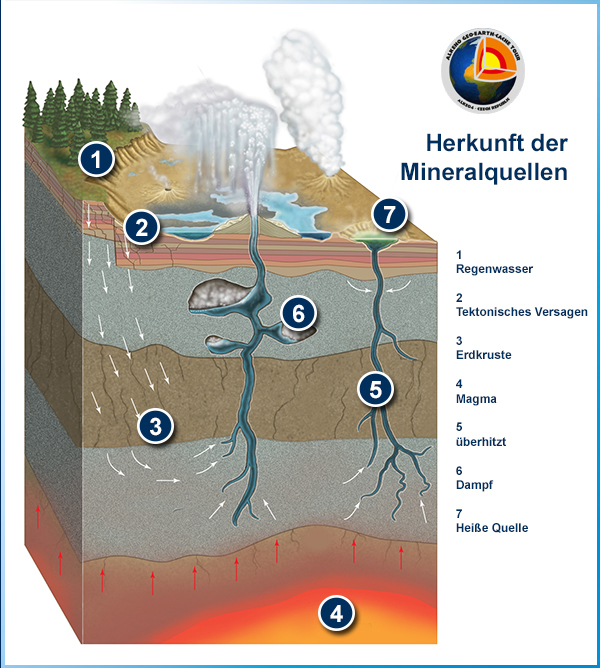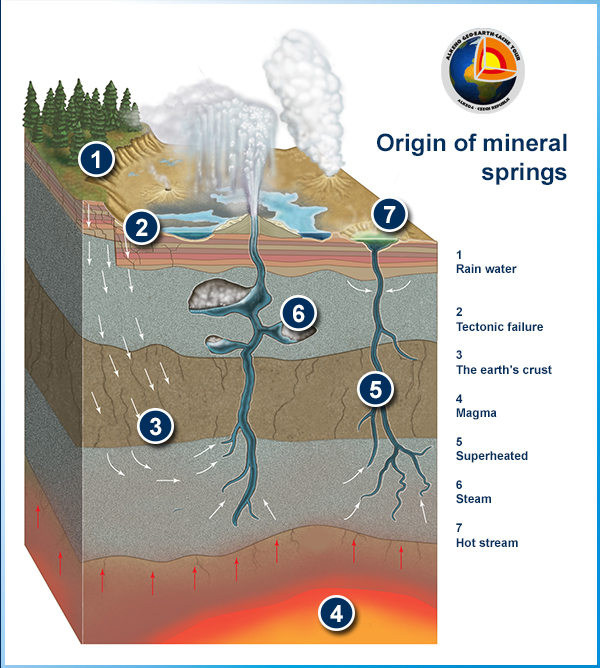|
GEOLOGIE
Die Entstehung von heißen Quellen steht in direktem Zusammenhang mit der Entstehung der Alpen.
Die Alpen entstanden durch eine Kollision der apulischen und eurasischen Tektonikplatten, bei der der westliche Teil des ursprünglichen Tethys-Ozeans verschwand. Die große mechanische Spannung während ihrer Kollision wirkte sich auf die Felsen am Boden des Tethys-Beckens aus und führte zu Faltenbildung, Umlagerungen, Abschälung und nach Norden in den Vordergrund, in Form von Blättern. Das Vorland der Alpen wird von der Europäischen Plattform und dem Zentralmassiv, den Vogesen, dem Schwarzwald und dem Böhmischen Massiv gebildet. Die größten schauerbildenden Bewegungen fanden in der Kreidezeit, im Oligozän und im Miozän statt. Während dieser Bergbildungsprozesse wurden viele ältere Einheiten, die heute die höchsten Teile des Gebirges bilden, in die Alpen gefaltet.
Derzeit herrscht die Meinung vor, dass Regenwasser aus den Bergregionen Graukogel und Hüttenkogel in einer Höhe von ca. 1800 m ü. M. austritt.
Aufgrund von tektonischen Störungen erreicht das Wasser eine Tiefe von 2000 Metern unter der Oberfläche. Hier wird auf 400 ° C aufgeheizt.

Aus einer heißen Quelle austretendes Wasser wird geothermisch erwärmt, dh mit Wärme, die aus dem Erdmantel stammt. Im Allgemeinen steigt die Temperatur der Gesteine in der Erde mit der Tiefe. Die Geschwindigkeit des Temperaturanstiegs mit der Tiefe ist als geothermischer Gradient bekannt. Wenn Wasser tief genug in die Kruste eindringt, erwärmt es sich, wenn es mit heißen Steinen in Berührung kommt. Das Wasser aus heißen Quellen in nicht vulkanischen Gebieten wird auf diese Weise erwärmt.
Ein Großteil der Wärme entsteht durch den Zerfall natürlich radioaktiver Elemente. Schätzungsweise 45 bis 90 Prozent der der Erde entweichenden Wärme stammen aus dem radioaktiven Zerfall von Elementen, die sich hauptsächlich im Erdmantel befinden. Die wichtigsten wärmeerzeugenden Isotope auf der Erde sind Kalium-40, Uran-238, Uran-235 und Thorium-232.
Hier gelangt Radon ins Wasser.
Radon ist ein chemisches Element. Es ist ein farbloses, radioaktives, geruchloses, geschmackloses Edelgas. Es tritt natürlich in winzigen Mengen als Zwischenschritt in den normalen radioaktiven Zerfallsketten auf, durch die Thorium und Uran langsam in Blei und verschiedene andere kurzlebige radioaktive Elemente zerfallen. Radon selbst ist das unmittelbare Zerfallsprodukt von Radium. Da jedoch Thorium und Uran zwei der am häufigsten vorkommenden radioaktiven Elemente auf der Erde sind und drei Isotope mit sehr langen Halbwertszeiten in der Größenordnung von mehreren Milliarden Jahren aufweisen, wird Radon auf der Erde auch in Zukunft vorhanden sein von seiner kurzen Halbwertszeit, wie es ständig erzeugt wird.
Es gibt 18 Thermalquellen, die reich an Mineralien und heilendem Radon sind. Fünf Millionen Liter thermisches Radonwasser mit einer Temperatur von 40-50 ° C fließen täglich durch das Spa. Innerhalb des Naturlehrpfades ist nur eine Quelle zu sehen, die anderen Quellen sind strikt vor dem Kontakt mit Oberflächenwasser geschützt.
GEOLOGY
The formation of hot springs is directly related to the formation of the Alps.
The Alps originated as a result of a collision between the Apulian and Eurasian tectonic plates, during which the western part of the original Tethys Ocean disappeared. The great mechanical tension during their collision affected the rocks at the bottom of the Tethys basin, causing them to wrinkle, toggle rearrangements, to peel off and to the north to the foregrounds, in the form of sheets. The foreland of the Alps is formed by the European Platform and the Massif Central, Vosges, Schwarzwald and Bohemian Massif. The greatest horror-forming movements occurred in the Cretaceous, Oligocene and Miocene. During these mountain-forming processes, many older units, which today form the highest parts of the mountains, have been folded into the Alps.
The currently prevalent opinion is that rain water leaks out of the Graukogel and Hüttenkogel areas of the mountain at an altitude of about 1800 above sea level.
Due to tectonic faults, water reaches a depth of 2000 meters below the surface. Here it is heated up to 400°C.

Water issuing from a hot spring is heated geothermally, that is, with heat produced from the Earth's mantle. In general, the temperature of rocks within the earth increases with depth. The rate of temperature increase with depth is known as the geothermal gradient. If water percolates deeply enough into the crust, it will be heated as it comes into contact with hot rocks. The water from hot springs in non-volcanic areas is heated in this manner.
Much of the heat is created by decay of naturally radioactive elements. An estimated 45 to 90 percent of the heat escaping from the Earth originates from radioactive decay of elements mainly located in the mantle. The major heat-producing isotopes in the Earth are potassium-40, uranium-238, uranium-235, and thorium-232.
This is where radon enters the water.
Radon is a chemical element. It is a colorless, radioactive, odorless, tasteless noble gas. It occurs naturally in minute quantities as an intermediate step in the normal radioactive decay chains through which thorium and uranium slowly decay into lead and various other short-lived radioactive elements; radon itself is the immediate decay product of radium. However, since thorium and uranium are two of the most common radioactive elements on Earth, and they have three isotopes with very long half-lives, on the order of several billions of years, radon will be present on Earth long into the future in spite of its short half-life as it is continually being generated.
There are 18 thermal springs rich in minerals and healing radon. Five million liters of thermal radon water at a temperature of 40-50 ° C flows through the spa every day. Only one spring can be seen within the nature trail, the other springs are strictly protected from contact with surface water.
|